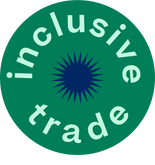Cotton - good or bad?
- Inclusive Trade thanks Lidia Callejo, a passionate environmental and sustainable lifestyle enthusiast for this article.
On our last post we explored the clothing industries contribution to soil degradation and drought and discussed recommendations to reduce our impact, amongst which was increasing our knowledge of the environmental impact of fibres.
To help you navigate the overwhelming amount of information out there, we are going to dedicate a series of short posts to exploring the most common fibres providing you with bite sized thinking pieces which will hopefully trigger more questions within you and your buying practises.
Before we jump to discussing the fibre in discussion on this post, lets identify the main categories of textile fibres that we use for most of our everyday needs across fashion and lifestyle products.
For the purposes of our posts, we are going to group our fibres into the following:
- natural fibres, these are either: plants fibres (like cotton, flax or jute) or protein fibres (like wool or silk).
and
- man-made regenerated fibres (e.g. viscose, lyocell) and synthetic fibres (eg. Polyester, polacryclic, polyeutherane, etc).
We are starting off this series with the most mainstream crop, cotton!
Approximately half of all textiles are made of cotton.
Its widespread use is due to its numerous benefits, which include:
- strength, abrasion resistance and durability
– its multilayered structure makes it a very strong fibre, so strong that that the Incas used it to make their amors! (check out this TED talk to find out more!).
- good breathability and moisture control
– as a natural fibre it is breathable and allows more air circulation than synthetic fabrics. It also retains less odor than other fibres.
- Overall comfort: it is soft and hypoallergenic.
So far so good, but cotton does have a few weaknesses:
- it can be more expensive than synthetic fibres,
- it is subject to shrinking
- it wrinkles easily.
However, the biggest downside to cotton is its environmental footprint.
Cotton cultivation and processing uses large amounts of water (20,000 liters of water are needed to produce 1kg of cotton), it contributes to the degradation of the soil quality which is further accentuated in the case of conventional practices due to the use of fertilizers, pesticides and chemicals all of which also contaminate water. Although cotton is only grown on 2.5% of the world’s agricultural land, it consumes 16% of all the insecticides and 6,8% of all herbicides used worldwide. (sources: WWF & organiccotton.org)
In light of this information one may consider shifting away from cotton or shift to organic cotton cultivation practices. But the solution is not so simple… The cotton industry is crucial to the livelihoods of many. It is a large industry and its production alone accounts for almost 7% of all employment in many low-income countries.. This is why it is crucial that through our purchase we support fair trade and ethically sourced cotton. Check for certifications and cotton which is part of initiatives, such as the Better Cotton Initiative. (source: WWF)
Organic cotton does not use toxic insecticides, herbicides or fungicides switching our demand to organic cotton would drastically reduce the water contamination and in part the soil degradation aspects associated to cottons production. If all the cotton in the world were grown organically, the use of insecticides could be reduced by 25 percent! (source: organic.com ).
However, pesticides and chemicals are used to increase the yield of the crop, so organic cotton has a much lower yield and hence uses up much more land and water. This is bad news if one has in mind a scale of production to meet our current demand…but here is where both the problem and solution lies, on our current demand trends!
The Ellen McArthur Foundation found that clothing use has declined by almost 40% whereas production has doubled in the last 15 years (source: EllenMcArthur Foundation).
Meeting the excessive and wasteful demand of fast fashion and its subsequent throwaway is hugely detrimental to conventional cotton cultivation. We must transition towards production and consumption characterised by sustainable and responsible practices and based on real demand.... Sustainable production would significantly reduce water pollution, promote efficient irrigation technologies and more environmentally friendly methods of production and it would pay workers fairly.
Sustainable consumption means simply buying transparent ethically sourced cotton products, and beyond the purchase, being mindful of how it is used and finally (if at all) disposed responsibly or upcycled as much as possible.
For more tips on improving your shopping habits Inclusivetrade.com offers a great free resource: 10 step sustainable shopping cheat sheet.
Sign up, and get in touch to get your free copy: social@inclusivertade.com
Reference links for further reading...
TED Talk - https://www.youtube.com/watch?v=tKLJ6KQAcjI
WWF Report on Cotton - https://www.worldwildlife.org/industries/cotton
The Fashion Industry of Today and cotton employment number - https://www.ellenmacarthurfoundation.org/explore/fashion-and-the-circular-economy#:~:text=Over%20the%20last%2015%20years,products%20in%20the%20first%20place.
Organic Cotton, Cotton Report - organic cotton site - https://www.organiccotton.org/oc/Cotton-general/Impact-of-cotton/Risk-of-cotton-farming.php
Organic - https://organic.org/introduction-to-organic-fibers/
